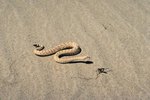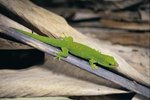
Florida is considered by many to be a land of sand and sea, not a land of lizards. However, Florida is home to a plethora of native and non-native species of lizards. The moderate climate and abundance of insects make Florida a hotbed of lizard activity.
Anoles
A number of varieties of anole inhabit Florida, but the green anole is the one indigenous to the United States. This small lizard, often referred to as chameleons due to their ability to change color from bright green to dark brown, are also popular in the Florida pet trade. Brown anoles, originally imported from Cuba and the Bahamas, are also common throughout Florida. Brown anoles are slightly larger than their green cousins, thrive in heavy vegetation and will often invade home gardens in search of food.
Skinks
Skinks are the most common type of lizard native to Florida, and numerous species enjoy the mild, subtropical Florida climate. The southeastern five-lined skink is one of the most numerous off all skink species and can be found in nearly every part of Florida. Adult skinks of this species have brown bodies and beautifully bright blue tails, making them easy to spot in the sand. Ground skinks are also common throughout Florida, although they look more like snakes than lizards. The ground skink has very short legs and slithers faster than it walks, making a quick escape by wriggling into the water or under a pile of vegetation. Broad-headed skinks are the largest of Florida’s skinks, often growing to more than a foot in length. These skinks stay mainly in dense, wooded areas, and may flee up trees when frightened.
Other Native Lizards
The glass lizard is one of Florida’s largest native lizards, sometimes growing to more than 3 feet long. Glass lizards are unique among lizards due to their body type and structure; they are virtually legless and spend much of their time buried in the soil. The six-lined racerunner is a sprinting lizard, outrunning most predators with ease. If cornered, this little lizard will bury itself in the sand to escape.
Other Non-native Species
Geckoes are also common in Florida, although there are no species native to the state. As the name suggests, the Mediterranean gecko hails from the warm region near the Mediterranean Sea. Florida’s warm, moist climate is ideal for the Indo-Pacific gecko, which traveled to the United States from Southeast Asia. Some invasive species are hazardous to native species, such as the carnivorous Nile monitor. This large lizard preys on native species, driving them out of their natural habitats. Omnivorous lizards, including the spiny-tailed black iguana and the green iguana, can peacefully co-exist with native lizards as long as there are adequate resources.
References
Photo Credits
-
Jupiterimages/Photos.com/Getty Images
Writer Bio
Louise Lawson has been a published author and editor for more than 10 years. Lawson specializes in pet and food-related articles, utilizing her 15 years as a sous chef and as a dog breeder, handler and trainer to produce pieces for online and print publications.




